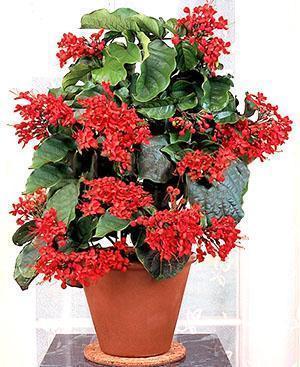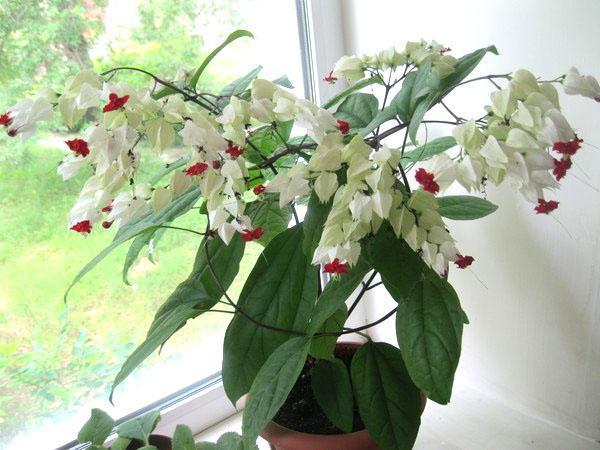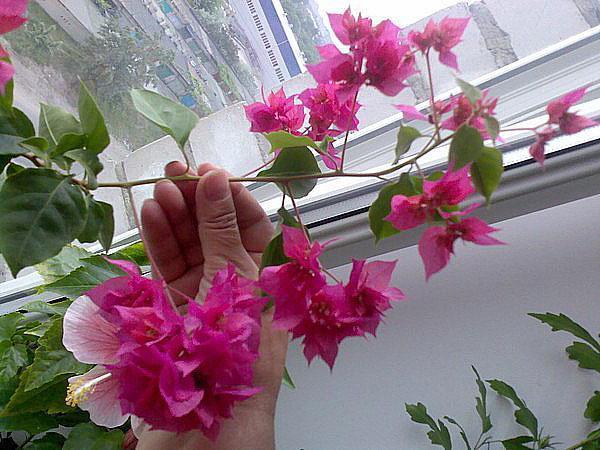Recommendations for home care for clerodendrum
 In indoor floriculture, the tree of fate can look like a bush, liana or a small tree, as in the photo. Clerodendrum home care requires complex, but will reward you with beauty and aroma. Any deviation from the tropical climate in the apartment creates problems in growing a flower. In home breeding, the most common varieties are brilliant and Clerodendrum Thompson.
In indoor floriculture, the tree of fate can look like a bush, liana or a small tree, as in the photo. Clerodendrum home care requires complex, but will reward you with beauty and aroma. Any deviation from the tropical climate in the apartment creates problems in growing a flower. In home breeding, the most common varieties are brilliant and Clerodendrum Thompson.
How to care for clerodendrum at home
There are no trifles in the agricultural technology of a flower. Compliance with the conditions of detention for a beautiful flowering is mandatory. But they are all doable and the caring owner will be grateful to the clerodendrum for their care, admire the photo!

- Place the plant on an east or west window so that there is enough light, but the direct rays do not burn the tree of fate.
- Water often, but so that the ground above is damp, there was no stagnation of water. In winter, watering is reduced.
- The temperature in summer should be 18-25 degrees, and in winter 13-15, and this is very important for abundant flowering.
- Create a damp area around the flower with a drain pan in water poured below the level for placing the planter. Frequent spraying of the plant on the leaves helps to rehydrate it.
- Feed once a week in summer and once a month in winter with a special liquid compound for flowering indoor plants.
- Pruning is one of the methods of caring for clerodendrum to preserve the shape of the bush and its decorative effect, twigs are material for propagation.
- Transplant the flower regularly, preferably by transshipment.
At each stage, the florists noticed the peculiarities of the care and worked out techniques on how to create tropics in the apartment on the windowsill.
Home care for the clerodendrum is determined by the shape, as in the photo.
You can create a bush by shaping that is convenient to care for. A liana-shaped plant, in which thin branches diverge in different directions, at the behest of a florist, is no less picturesque. The shape is created by cropping.
When and how to prune
In favorable conditions and with good care of the clerodendrum at home, the vine can grow up to four meters in length. Therefore, pruning is carried out in several stages.
In winter, when the plant has shed its leaves, the shoots are removed by a third, this stimulates subsequent branching and flowering. In order to create a bush, at the beginning of a set of green mass, young twigs are shortened a little more. To get a stem, you need to leave one shoot, constantly clearing it of emerging branches. Root shoots are also plucked out.
The plant itself is capable of regulating its growth. In winter, some of the twigs dry out, which is normal. And in the summer, if the flowers have wilted, the twig needs to be cut off and new shoots will grow, on which the buds will bloom.
For summer bloom, it is important to keep the winter cool. In this case, the leaves may turn yellow and crumble, and this is not a problem, the physiology of the plant. In early spring, in the photo, clerodendrum looks like this when caring for home.
Transplant and reproduction
 Transplantation and reproduction are important operations in the care of the Clerodendrum flower. After five years, the flowering of the bush decreases and it is important to grow a replacement for it. To do this, you can use cuttings obtained during pruning.
Transplantation and reproduction are important operations in the care of the Clerodendrum flower. After five years, the flowering of the bush decreases and it is important to grow a replacement for it. To do this, you can use cuttings obtained during pruning.
The root system of the flower does not like to be disturbed.Therefore, the transplanting method should be transhipment into a large container with a prepared drainage layer. The substrate is prepared in equal parts:
- clay turf;
- leafy land;
- peat;
- sand.
The plant is transplanted in early spring before the start of sap flow. Before that, trimming is done. The transplanted clerodendrum is watered with fertilizer and placed in a warm place, giving a signal that it is time to wake up.
The cut branches can be placed in water, and later rooted in the ground. If the cuttings are rooted in a peat-sand mixture, then lower heating and a greenhouse are required. Transplant rooted cuttings after a year. You can grow a new plant from the collected seeds.
If the home flower did not have the conditions for a dormant period, it may not bloom. It does not bloom if the soil is old, irregular fertilizing. Violations of the conditions of detention in the summer will lead to yellowing and leaf fall.
Diseases and pests of clerodendrum
With insufficient care, ordinary indoor insects and plant pests can settle on a weakened plant. These include:
- spider mite;
- whitefly;
- aphid.
Only urgently taken measures can protect the entire bush from colonizing the whitefly. It mines leaves under the top layer and the larvae are difficult to enter.
 Spider mites are found with punctures on the leaves and yellowing. When there are many of them, the cobweb is visible to the naked eye.
Spider mites are found with punctures on the leaves and yellowing. When there are many of them, the cobweb is visible to the naked eye.
If home remedies do not help in the fight against insects, Actellik, Fufan or Fitoverm should be used. Repeat the treatment several times at intervals of 3 days.
If the leaves of the flower begin to turn yellow in the summer, then it is necessary to carry out foliar feeding with Ferrovit, and then look for the cause of chlorosis. It lies in non-observance of flower agricultural techniques.
It is not so difficult to create conditions for an indoor Clerodrendum flower, it just requires constant attention, and the flower will endow it with wonderful flowering and aroma.
Thanks for the info. I really like Clerodendrum! For some reason, even beginners (rooted cuttings) have leaves that turn black around the perimeter and fall off. Please tell me what to do? Best regards, Valentine.
The reason for the blackening and subsequent fall of the clerodendrum leaves can be excessive frequent watering, as a result of which the water constantly stagnates in the soil. This is facilitated by the complete drying out of the earthen coma, if the plant was forgotten to water on time. The leaves also turn black due to the disease of the root system. The reason for the foliage to fall is also the excess dosage of fertilizers during fertilizing, especially if the drug was introduced into overdried soil.
And I have yellow leaves ... although it is spring now ...?
Look for a tick. If no one is found, then it may be chlorosis and need to be fed.
Tell me please, what is the reason for this state of my flower? He's 20 years old, sorry. This have not happened before. The leaves gradually flew around, in March I transplanted it into fresh soil somewhere, then it seemed to me that there was not enough light for it, I put it on another sunny window. He even conceived to bloom, but the only bud fell off, not blooming. And so. And the leaves are now flying around. I would be very grateful for your advice.